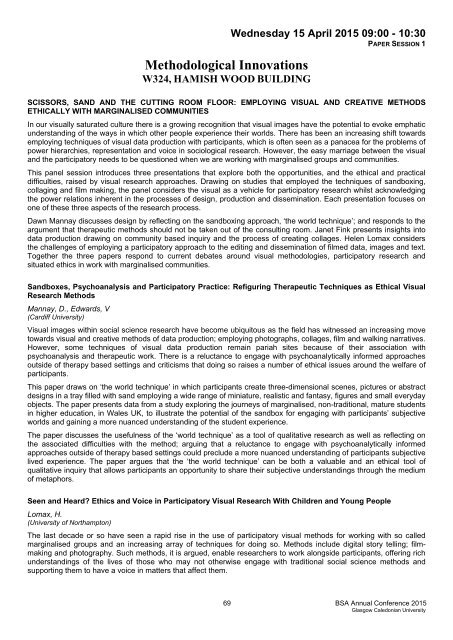Programme full
Programme full
Programme full
You also want an ePaper? Increase the reach of your titles
YUMPU automatically turns print PDFs into web optimized ePapers that Google loves.
Methodological Innovations<br />
W324, HAMISH WOOD BUILDING<br />
Wednesday 15 April 2015 09:00 - 10:30<br />
PAPER SESSION 1<br />
SCISSORS, SAND AND THE CUTTING ROOM FLOOR: EMPLOYING VISUAL AND CREATIVE METHODS<br />
ETHICALLY WITH MARGINALISED COMMUNITIES<br />
In our visually saturated culture there is a growing recognition that visual images have the potential to evoke emphatic<br />
understanding of the ways in which other people experience their worlds. There has been an increasing shift towards<br />
employing techniques of visual data production with participants, which is often seen as a panacea for the problems of<br />
power hierarchies, representation and voice in sociological research. However, the easy marriage between the visual<br />
and the participatory needs to be questioned when we are working with marginalised groups and communities.<br />
This panel session introduces three presentations that explore both the opportunities, and the ethical and practical<br />
difficulties, raised by visual research approaches. Drawing on studies that employed the techniques of sandboxing,<br />
collaging and film making, the panel considers the visual as a vehicle for participatory research whilst acknowledging<br />
the power relations inherent in the processes of design, production and dissemination. Each presentation focuses on<br />
one of these three aspects of the research process.<br />
Dawn Mannay discusses design by reflecting on the sandboxing approach, ‘the world technique’; and responds to the<br />
argument that therapeutic methods should not be taken out of the consulting room. Janet Fink presents insights into<br />
data production drawing on community based inquiry and the process of creating collages. Helen Lomax considers<br />
the challenges of employing a participatory approach to the editing and dissemination of filmed data, images and text.<br />
Together the three papers respond to current debates around visual methodologies, participatory research and<br />
situated ethics in work with marginalised communities.<br />
Sandboxes, Psychoanalysis and Participatory Practice: Refiguring Therapeutic Techniques as Ethical Visual<br />
Research Methods<br />
Mannay, D., Edwards, V<br />
(Cardiff University)<br />
Visual images within social science research have become ubiquitous as the field has witnessed an increasing move<br />
towards visual and creative methods of data production; employing photographs, collages, film and walking narratives.<br />
However, some techniques of visual data production remain pariah sites because of their association with<br />
psychoanalysis and therapeutic work. There is a reluctance to engage with psychoanalytically informed approaches<br />
outside of therapy based settings and criticisms that doing so raises a number of ethical issues around the welfare of<br />
participants.<br />
This paper draws on ‘the world technique’ in which participants create three-dimensional scenes, pictures or abstract<br />
designs in a tray filled with sand employing a wide range of miniature, realistic and fantasy, figures and small everyday<br />
objects. The paper presents data from a study exploring the journeys of marginalised, non-traditional, mature students<br />
in higher education, in Wales UK, to illustrate the potential of the sandbox for engaging with participants’ subjective<br />
worlds and gaining a more nuanced understanding of the student experience.<br />
The paper discusses the usefulness of the ‘world technique’ as a tool of qualitative research as well as reflecting on<br />
the associated difficulties with the method; arguing that a reluctance to engage with psychoanalytically informed<br />
approaches outside of therapy based settings could preclude a more nuanced understanding of participants subjective<br />
lived experience. The paper argues that the ‘the world technique’ can be both a valuable and an ethical tool of<br />
qualitative inquiry that allows participants an opportunity to share their subjective understandings through the medium<br />
of metaphors.<br />
Seen and Heard? Ethics and Voice in Participatory Visual Research With Children and Young People<br />
Lomax, H.<br />
(University of Northampton)<br />
The last decade or so have seen a rapid rise in the use of participatory visual methods for working with so called<br />
marginalised groups and an increasing array of techniques for doing so. Methods include digital story telling; filmmaking<br />
and photography. Such methods, it is argued, enable researchers to work alongside participants, offering rich<br />
understandings of the lives of those who may not otherwise engage with traditional social science methods and<br />
supporting them to have a voice in matters that affect them.<br />
69 BSA Annual Conference 2015<br />
Glasgow Caledonian University


